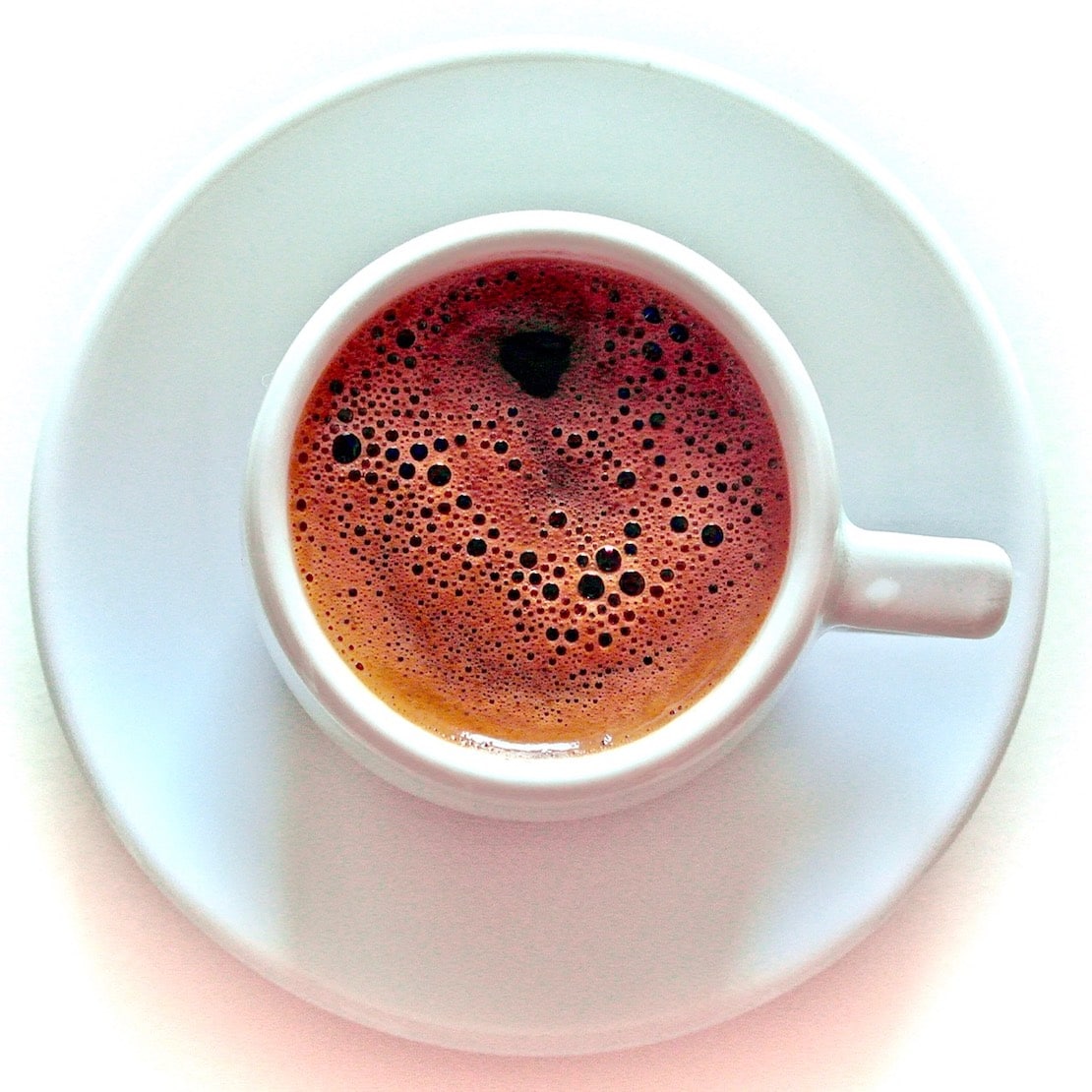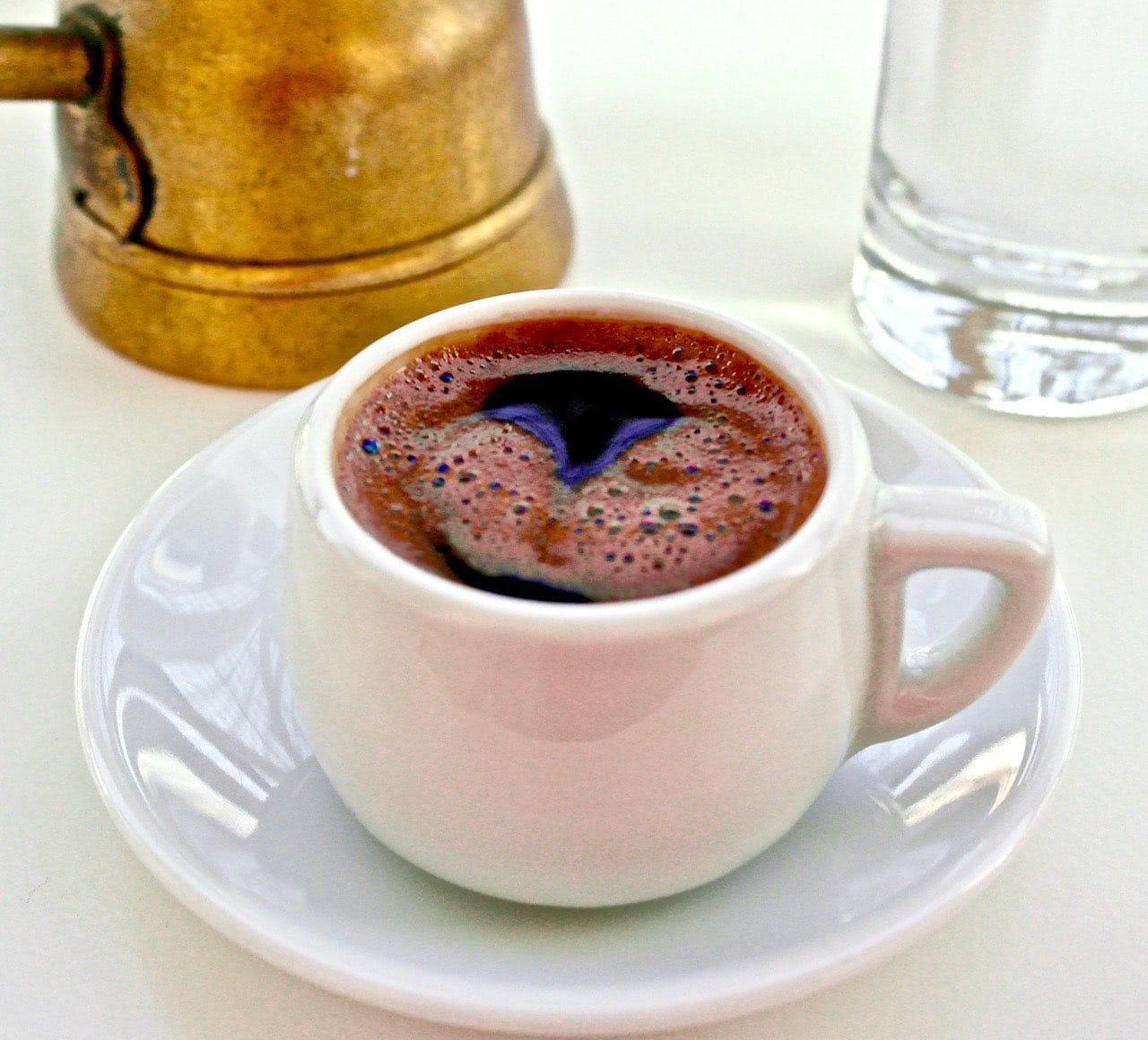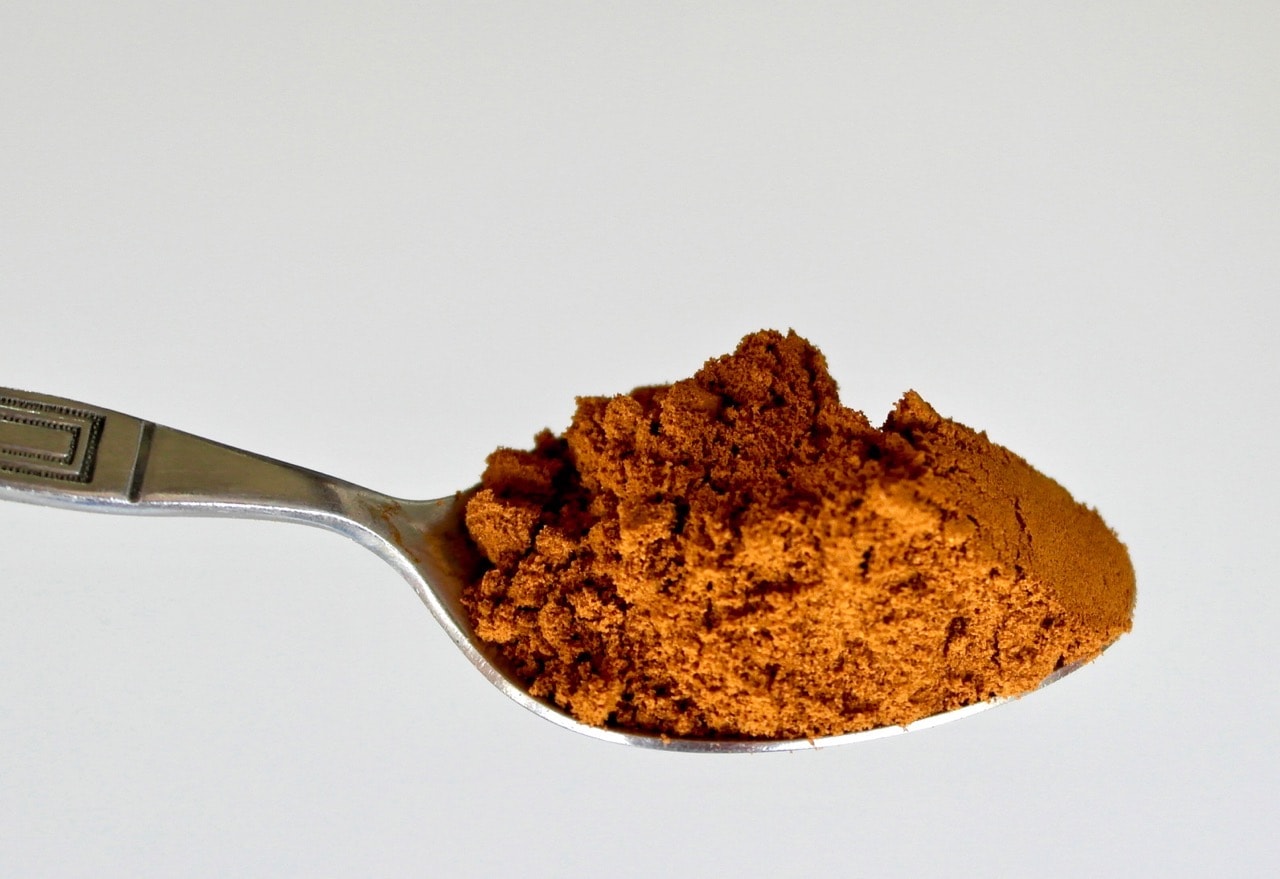Greek Coffee
Learn how to make authentic Greek coffee and how to enjoy it. This boiled Greek coffee has a rich, smooth flavor and a velvety texture, with a wonderful sweet aroma.

The aroma of Greek coffee always brings me right back to my childhood. Mornings started with that familiar aroma, as I would walk in the kitchen, my mom had prepared her coffee and was looking forward to enjoying it, while we had our breakfast. But what I remember and still enjoy even more are the afternoons, when later as an adult we’d have Greek coffee together after the “mesmeri”, the Greek quiet time. Greek coffee has always been more than just a drink; it’s a part of our day, no matter the time. Even now, whenever I visit my parents, my mom always asks me to make her a cup because, as she says, I make it just right.
The variations are limitless. Although you obviously won’t add milk or syrups to it, however the ratio of sugar to coffee, the amount of coffee, the length of time it is boiled, whether it has bubbles or not, all these are factors that can affect the taste and texture of the coffee. So in this post I will show you how I make the coffee and present the numerous other ways it can be prepared.
What is Greek Coffee?
Greek coffee is a finely ground coffee that is boiled. The consistency is rich but also mild tasting, milder than espresso. It also has less caffeine than espresso. To prepare it, the coffee is added to water and then heated slowly on low heat. Eventually the coffee becomes thick, developing a nice foam on top. It is served in demitasse cups, they are slightly larger than an espresso cup. Greek coffee differs in several ways from other coffee. It is made from a combination of variety of Santos which is an Arabica variety, and Robusta which provides the creaminess.
The texture is very fine and what makes the biggest difference in flavor is the way it is roasted. Greek coffee tends to be milder than other types of similar (Turkish/Arab) coffee, this comes down to roasting method. In addition, Greek coffee does not contain any spices such as cardamon which you may find in other similar types of coffee.
I need to note that you can’t just grind your favorite coffee beans in a fine powder and expect to have Greek style coffee. This is not the case. Α specific combination of beans is used to make this Greek blend, with specific bean varieties, roasted at specific temperatures and used in specific ratios. If there is a place that grinds/roasts Greek/Turkish/Arab style coffee near you, then by all means get the coffee from there. If not, many ethnic super markets sell it and you can also order Greek coffee from Amazon, they carry the 2 popular Greek brands Loumidis and Bravo.
Greek Coffee Health Benefits: The Dietitian’s Take
We have known for a while that coffee can be good for you and particularly Greek style coffee as a recent study on elderly Greeks showed us. Greek coffee contains high amounts of cafestol and kahweol, substances that appear to have ant-inflammatory and antioxidant properties. In addition, Greek style coffee has moderate caffeine levels. A few years ago, a similar Greek study about Greek coffee found that consumption of Greek coffee improved the elasticity of arteries in individuals with high blood pressure. In another study that was conducted on the inhabitants of the Greek island of Ikaria who have one of the highest longevity rates, it was found that those who consumed Greek coffee regularly had better endothelial function than those who consumed other types of coffee. The endothelial is a group of cells that line the interior of blood vessels. When these cells are not functioning properly, it may lead to atherosclerosis-hardening of the arteries.
Greek Coffee Ingredients and Equipment
You will need some equipment to make a proper Greek coffee.
- A gas source. In Greece most people used to have gas stove tops, nowadays these have been replaced with electric stove tops, which I am not very fond of, as I cannot see flame. Since most people no longer have gas stove tops, here they use what you call a gazaki, it is a single camping gas burner. Traditionally this type of coffee is made in what is called hovoli, which is basically heated sand.
- Get a small coffee pot called a briki. There are different sizes, I like to have 2 sizes, one that can make only 1 serving and one for 2 servings.
- Espresso coffee cup or Greek coffee cup like the one in the photo
- Greek Coffee: Make sure you use Greek brands as the coffee has a different roasting method and a different intensity, it is milder generally. You can use other brands but they may be stronger or also have spices added to them.
- Sugar. Do not use sugar substitutes or brown sugar, you will not get the texture or flavor you are looking for.
How To Make Greek Coffee

- Measure out a full coffee cup of water (about 2 1/2 -3 ounces or 75-90 mls) and pour into the briki. If you are making more than one coffee make sure your briki is big enough, you will need space to let the coffee bubble and foam.
- Add 2 teaspoons of coffee and 2 teaspoons of sugar for every 1 coffee cup and stir. This ratio is considered a somewhat strong coffee.
- Place the briki on the gas and turn on so that it is on low heat.
- Very slowly let the coffee heat up, (keep the flame very-very low). Do not leave the coffee unattended.
- You will slowly see the surface start to tremble (I describe it like a volcano waiting to explode). Once it starts foaming, lift it slightly from the heat until the foam/bubbles settle and then put it on the fire again and let it start foaming and puffing up. Then remove. This step is important to get a good coffee. You don’t want to let it over-boil otherwise it will not have that creamy/foam on top, but you don’t want it under-boiled because then you may taste the grounds in the coffee.
- Serve in the coffee cup. If you are making more than one, separate the foam in each coffee cup. However, I prefer to make each coffee separately or at most 2 servings per brick.
- Serve the cup on a small saucer with a glass of cold water.
How to drink Greek coffee
While this is a small coffee, it is not to be confused with the espresso, which is basically consumed quickly standing up. This coffee is consumed sitting down slowly, it will usually take at least 1/2 hour. To get the full flavor you should sip the coffee slowly. I remember the older generations taking loud sips of coffee; while this may be rude, I find that it increases the enjoyment of the coffee. Once you start tasting the first grounds you are done. Do not try and drink the coffee grounds at the bottom of the cup.
In Greece, traditionally coffee was consumed two times a day: In the morning and in the afternoon after their nap. Although the coffee seems thick and black it is not extremely high in caffeine, it is actually lower than regular filter coffee.
What to Serve with Greek Coffee
Greek coffee is always served with a glass of cold water. You can accompany it with a sweet, the classic accompaniment is a koulouraki such as the classic Koulourakia- Greek Butter Cookies, or the vegan version Olive Oil Cinnamon Cookies – Kolourakia Lathiou, you can also accompany with bite-size sweets such as these Greek Island Almond Sweets – Amygthalota or these Almond-Cocoa Bites.
Different Preparations of Greek Coffee
As I mentioned earlier there are different ways to enjoy coffee (some say that there are 45 different ways to prepare Greek coffee), so you may always reduce the sugar or not add any at all. The way I make it is considered somewhat moderate to strong. Here are some of the ways it can be consumed:
- Plain pronounced Sketos: Only coffee and no sugar
- Strong pronounced Varis : 2-3 teaspoons of coffee with 1 teaspoon sugar
- Light pronounced Elafris : ½-1 teaspoon of coffee + 1 teaspoon sugar
- Sweet pronounced Glykos : 1 teaspoon coffee +2 teaspoons sugar
- Strong-Sweet pronounced Variglykos : 3 teaspoons coffee +3 teaspoons sugar
- Yes and No pronounced Ne ke Ohi : 1 teaspoon coffee + ½ teaspoon sugar
Insider Tips to Make the Best Greek Coffee
I don’t mean to brag but the elders in my family tell me I make the best Greek coffee. Here are my tips:
- Don’t make large amounts all at once. Good Greek coffee is made in separate servings, so make sure you have an appropriate sized briki as it is important for proper boiling and foam development. If it is too big your coffee will boil too quickly.
- Use the correct coffee. Again make sure you buy the right kind, otherwise it will taste nothing like real Greek coffee.
- Don’t hurry it. Greek coffee needs a few minutes, not too long but you also don’t want it to quickly boil it either. And you definitely don’t want it to come to a complete boil either, this will result in no foam.
- Pay attention to the ratio of sugar to coffee, see the amounts above and experiment.
Greek Coffee

Equipment
- 1 Small coffee pot called a briki
Ingredients
Special Equipment
- Gas Source see above
- Small coffee pot called a briki.
- Espresso cup or Greek coffee cup
Instructions
- Measure out a full coffee cup of water (about 2 1/2 -3 ounces or 75-90 mls) and pour into the briki. If you are making more than one coffee make sure your briki is big enough, you will need space to let the coffee bubble and foam.
- Add 2 teaspoons of coffee and 2 teaspoons of sugar for every 1 coffee cup and stir. This ratio is considered a somewhat strong coffee.
- Place the briki on the gas and turn on so that it is on low heat.
- Very slowly let the coffee heat up, (keep the flame very-very low). Do not leave the coffee unattended.
- You will slowly see the surface start to tremble (I describe it like a volcano waiting to explode). Once it starts foaming, lift it slightly from the heat until the foam/bubbles settle and then put it on the fire again and let it start foaming and puffing up. Then remove. This step is important to get a good coffee. You don’t want to let it over-boil otherwise it will not have that creamy/foam on top, but you don’t want it under-boiled because then you may taste the grounds in the coffee.
- Serve in the coffee cup. If you are making more then one, separate the foam in each coffee cup.
- Serve the cup on a small saucer with a glass of cold water.
Notes
- Plain pronounced Sketos: Only coffee and no sugar
- Strong pronounced Varis: 2-3 teaspoons of coffee with 1 teaspoon sugar
- Light pronounced Elafris: ½-1 teaspoon of coffee + 1 teaspoon sugar
- Sweet pronounced Glykos: 1 teaspoon coffee +2 teaspoons sugar
- Strong-Sweet pronounced Variglykos: 3 teaspoons coffee +3 teaspoons sugar
- Yes and No pronounced Ne ke Ohi: 1 teaspoon coffee + ½ teaspoon sugar


Hi there! I was wondering if the effects and health benefits would be the same with a bialetti moka? It seems like it might, but not sure. Thanks!
I tried the Bravo coffee using a birki and a camp stove. I got the froth perfect and the flavor is to die for, however I’m finding sources that show Greek/Turkish coffee has a much higher caffeine content than American drip coffee. I also had horrible, major headaches while drinking the Bravo. Headaches that lasted for days after 1 serving. This does not happen with Italian or Cuban espresso or drip coffee for me. Was something wrong with the coffee? Or is the caffeine content actually higher than espresso or drip blends? Love your recipes by the way. My favorite website.
Greek/Turkish coffee has less caffeine than regular filter coffee. The grounds are not consumed and you want to make sure that it is boiled enough so there are no grounds when you are drinking it. There may be a substance in the coffee that you have a sensitivity to. You can try another brand, Loumidis is the most popular coffee here in Greece. Also be aware that Greek coffee is blonder than Turkish coffee which uses a dark roasted bean, so that means it also has a milder flavor than Turkish coffee.
Mitzy, were you drinking coffee regularly before you tried the Greek coffee? If so, you were likely experiencing caffeine withdrawal. You can get headaches from suddenly stopping caffeinated beverages. If you would like to cut down on caffeine, then I would take an ibuprofen for a few days following until the headaches stop.
Hello Elana,
I’ve recently begun enjoying the Mediterranean diet and lifestyle and I want to say thank you so much for all of your delicious recipes and tips! I do have a question when it comes to the Briki’s. Is there a preference of the material it is made from? I have seen copper and stainless steel.
Thank you!
Both are fine. Copper is more traditional.
Hello, I’m Greek & I’ve always drank my Greek coffee with cardomon!
I just tried it for the first time ever today… HOW HAVE I LIVED MROE THAN 20YEARS AND JUST AM HAVING THIS!?!?! So many regrates but perhaps this my greatest! THERE’S NO OTHER WAY I WANT IT NOW, AHHH!!! <3 Magic and love and all that is good in this world in a cup!
I am inspired by your writings which brings back memories of Yaya and her Greek girlfriends that used to gather in the afternoon for talk and treats, and ‘Turkish’ coffee. I still have the brass brikies. Your recipe and method is the same as Yaya and Mother taught me, only they allowed foaming to happen 3 times (maybe for the trinity). As a retired senior, I will dust off the briki and bring them back to life. Love your writings.
This sounds so good! I am curious though (I always have to worry about something when I should just live my life): I’ve seen some articles that boiled, unfiltered coffee can raise cholesterol. Does this potentially have that effect or because the grounds aren’t consumed is it less likely to cause any issues with cholesterol? I know traditional Greeks are very healthy in general and face very few lifestyle related diseases so I would think either this coffee doesn’t cause cholesterol raising or because the diet is so healthy it would make up for that. Just wondering if you know more about this. I’m still going to try it either way it sounds like it would be something I would love and I’ve been using a french press anyways so I’m sure that also would be considered unfiltered coffee.
I don’t have a gas stove only electric. I follow the instructions that my friend, who is Egyptian, told me. I can never get the frothy or foamy top like in all the pictures but it tastes pretty good.
This was so so so helpful! It’ll save me so much more money making it myself rather than constantly buying it. I sadly live in America when I would love to live in Greece. So this will help me make better coffee than any other places can offer!!
Thank you Blaire! Glad it was helpful!
Kalimera,
I’m sitting outside Als bar in Batsi, Andros. Been coming here for 20 years, loved your article on how to make proper Greek coffee, definitely going to bring a briki home with me this year. Can’t believe it’s taken me 20 years!!!
Best wishes,
Su
XX
Thank you for sharing! Enjoy your stay in Andros!
when on the beach in north greece, my aunt would soak cotton balls in either alcohol or something else that i cant remember, and she’d light them up and hold the briki over the flames. when there’s a craving, there’s a way
Thank you Elena! We are new converts to Greek coffee after our first visit to Greece. I feel much better drinking coffee like this than the way I used to! We now love our daily Greek coffee! Good to read about it . I work with over 100 women every week, dancing and will be introducing our dancers to the joys of Greek coffee.
Thank you Carla!
Though we liked Greek coffee we really did not drink it because making it on the stove was hugely unsuccessful! No patience… never managed to get a good kamaki on the top. Then we discovered the Beko Turkish/Greek auto coffee maker – with North American power – this little machine make a perfect cup of coffee every single time with the push of one button. It’s become our coffee of choice since we bought the machine.
I came here for tips on Greek coffee, but the rest of the content here looks great – hitting “Subscribe.”
Thanks Gus!
What is the cold cup of water for that you mention at the end.
After drinking the coffee you have a few sips of cold water.
I have just received my first order of Loumadis coffee and although I really liked it, am not sure if I made it correctly. Is 1 teaspoon, a level teaspoon or a heaped teaspoon? I used a level teaspoon with a half teaspoon of sugar, but I didn’t manage to get it to foam although I boiled it for several minutes. I did however, have the element on high … we don’t have gas. I will try again with the element on low next time.
Hi Margaret,
Have the element on low, it will take a bit more time but you should get the foam. If it is on high it will come to a boil too fast resulting in no foam.
Hi ~ I loved this article. When and why do you drink the cold water?
Thank You!
Thanks Regina,
During the coffee drinking